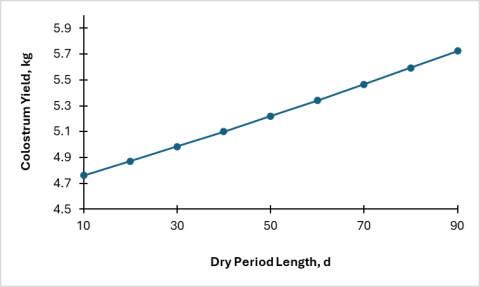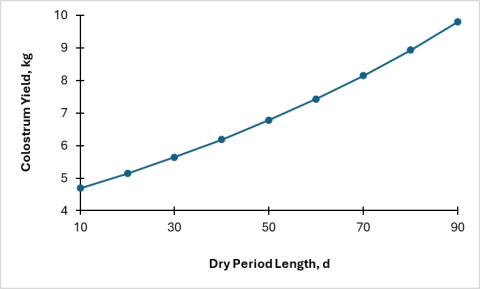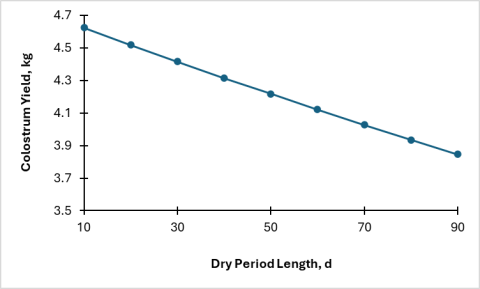Recently it has been observed on many farms that some cows do not produce colostrum or don’t produce enough colostrum to feed their calves. How can producers alleviate this challenge? This is the first in a series of articles to help correct this challenge.
Research worldwide has shown that shorter dry periods result in lower colostrum production. Data from New York from 19,000 cows indicated that approximately 12% of cows do not produce colostrum1. Data from across the US, analyzed at UNH, indicated that about 2.5% of Jerseys do not produce colostrum, and almost 25% do not produce enough colostrum to feed their calves2.
Why Is This Happening?
It appears that many farm characteristics affect the production of colostrum. Examples include the diet the cows are being fed, the amount of day length, and previous days open. Two major factors that affect colostrum yield are dry period length and environmental temperature. When the temperature is below 41° F, cows experience cold stress. When temperatures are above 68° F, cows are considered to undergo heat stress. Data from New York Holsteins showed that dry period length greater than 67 days improved colostrum yield1. A model to predict Jersey colostrum production was developed at UNH utilizing data from across the US at various times of the year showing that cows in the spring, summer, and fall produced more colostrum as dry period length increased2. Data collected from New Hampshire Holsteins was the first to show that cows make more colostrum during the summer months3. It appears that the longer the dry period, the better condition the cows are in, and likely the better energy status results in more colostrum. This has not been evaluated yet, but the results of several studies support this hypothesis. However, data with Jersey cows during the winter, especially when it is very cold, produce less colostrum when the dry period length is increased2. It is thought that these cows likely need more energy in their diet to produce colostrum but also maintain their core temperature. Lactating cows in the winter are likely to produce more heat in their rumen due to the consumption of more feed.
During the times of the year when temperatures are moderate and colostrum yield is compromised, try increasing dry period length by 10-20 d. However, shorter dry periods might help with colostrum yield during the winter. The following three figures show the changes that occur to Jersey cows based on data from herds from across the US.

This is a 150-cow herd, it is the 150th day of the year, the latitude is 40, the dry period length varies from 10 to 90 in 10 d increments, there are no days below 41°F, there are 10 d between 41-68°F, it takes 3 h to harvest colostrum, IgG =80g/L, cows were fed 1 time a day, not on pasture, and has 80 d previous lactation days open.

The same herd except all the days are above 68° and the 210th day of the year.

This is the same herd but it is the 30th day of the year, Days below the 41° F vary from 10-90 D. All else is the same. This is the effect of the cold.
1 Westhoff, T.A., S.J. Womack, T.R. Overton, C.M. Ryan, and S. Mann. 2023b. Epidemiology of bovine colostrum production in New York Holstein herds: Cow, management, and environmental factors. J. Dairy Sci. 106:4874:4895.
2 Stahl, T.C., E.M. Mullin, J.M. Pineiro, M. Lunak, M. Chahine, and P.S. Erickson. 2024. Creating models for the prediction of colostrum quantity, quality, and immunoglobulin G yield in multiparous Jersey cows from performance in the previous lactation and environmental changes. J. Dairy Sci. 107:4855–4870
3 Cabral, R.G., C. E. Chapman, K. M. Aragona, E. Clark, M. Lunak, and P. S. Erickson. 2016. Predicting colostrum quality from performance in the previous lactation and environmental changes. J. Dairy Sci. 99:4048–4055.
Dr. Peter Erickson is Professor of Dairy Management and Extension Dairy Specialist at the University of New Hampshire. His primary research area is in the area of optimal colostrum production and management through feeding of the prepartum cow and the newborn calf. He also works in the area of calf and heifer nutrition along with the feeding of alternative feedstuffs.
Dr. Sarah Allen and Dr. Glenda Perreira
Clara / stock.adobe.com 418946515

